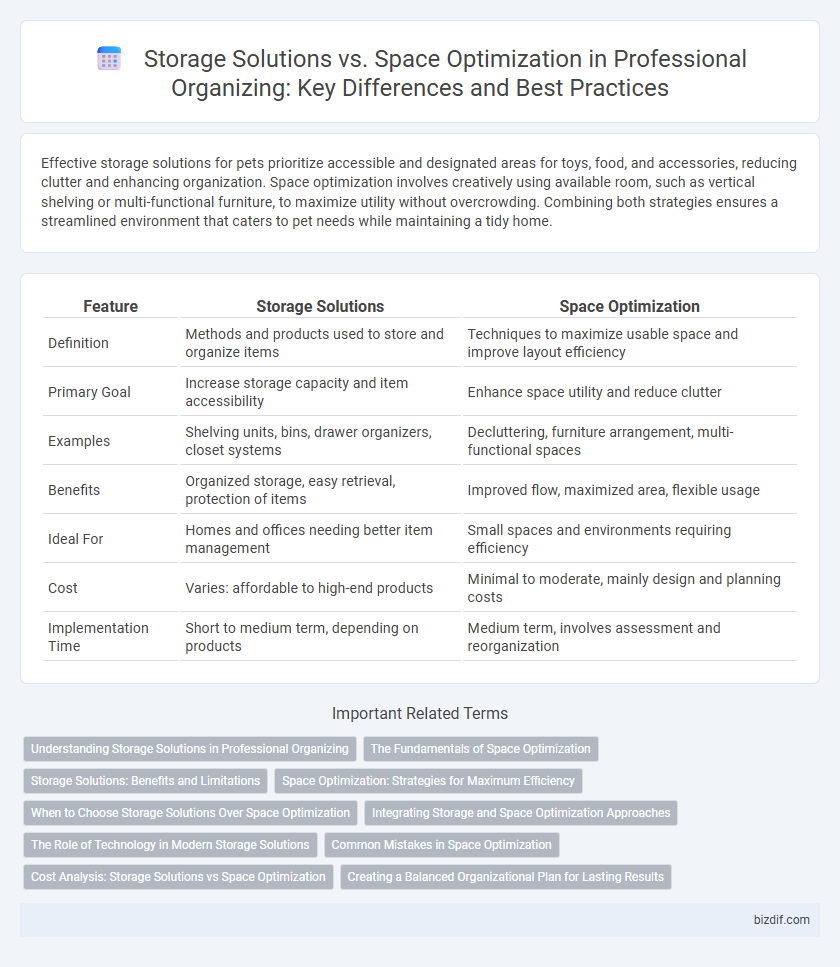Effective storage solutions for pets prioritize accessible and designated areas for toys, food, and accessories, reducing clutter and enhancing organization. Space optimization involves creatively using available room, such as vertical shelving or multi-functional furniture, to maximize utility without overcrowding. Combining both strategies ensures a streamlined environment that caters to pet needs while maintaining a tidy home.
Table of Comparison
| Feature | Storage Solutions | Space Optimization |
|---|---|---|
| Definition | Methods and products used to store and organize items | Techniques to maximize usable space and improve layout efficiency |
| Primary Goal | Increase storage capacity and item accessibility | Enhance space utility and reduce clutter |
| Examples | Shelving units, bins, drawer organizers, closet systems | Decluttering, furniture arrangement, multi-functional spaces |
| Benefits | Organized storage, easy retrieval, protection of items | Improved flow, maximized area, flexible usage |
| Ideal For | Homes and offices needing better item management | Small spaces and environments requiring efficiency |
| Cost | Varies: affordable to high-end products | Minimal to moderate, mainly design and planning costs |
| Implementation Time | Short to medium term, depending on products | Medium term, involves assessment and reorganization |
Understanding Storage Solutions in Professional Organizing
Storage solutions in professional organizing involve selecting and implementing tools like shelving units, bins, and containers to efficiently categorize and store items, improving accessibility and visual order. Effective storage systems are tailored to the specific environment, considering item types, frequency of use, and available space, ensuring durability and ease of maintenance. Understanding these solutions enhances clutter reduction and maximizes functional use of any space, directly contributing to improved productivity and stress reduction.
The Fundamentals of Space Optimization
Space optimization centers on maximizing the functional use of available areas through strategic layout and multi-purpose furnishings, unlike storage solutions that primarily focus on containment. Key fundamentals include analyzing traffic flow, prioritizing accessibility, and utilizing vertical space to reduce clutter and enhance efficiency. Proper implementation of these principles leads to a harmonized environment that supports productivity and ease of maintenance.
Storage Solutions: Benefits and Limitations
Storage solutions enhance organization by providing designated areas such as shelves, bins, and containers, which reduce clutter and improve accessibility. They offer tailored options for different items, facilitating efficient categorization and protection, but can sometimes consume valuable floor or wall space and may require frequent maintenance to avoid accumulation of unused goods. While excellent for managing possessions, storage solutions alone may not maximize the full potential of available space without integrating space optimization strategies.
Space Optimization: Strategies for Maximum Efficiency
Space optimization focuses on maximizing the utility of existing areas through strategic arrangement, multi-functional furniture, and vertical storage options. Techniques such as decluttering, zone creation, and customized shelving improve accessibility and workflow while reducing wasted space. Prioritizing space optimization enhances room functionality, making the environment more efficient and visually appealing.
When to Choose Storage Solutions Over Space Optimization
Storage solutions are ideal when there is a need to accommodate a high volume of items without structural changes, using tools like shelves, bins, and modular cabinets to maximize existing capacity efficiently. Space optimization becomes more suitable when reconfiguring or decluttering the layout can create additional room and improve flow, especially in small or awkward spaces. Choose storage solutions over space optimization when the priority is preserving current floor plans while increasing storage capabilities quickly and cost-effectively.
Integrating Storage and Space Optimization Approaches
Integrating storage solutions with space optimization techniques enhances functionality while maximizing available square footage, leading to a more efficient and clutter-free environment. Customized shelving, modular furniture, and multi-use storage units support seamless organization by adapting to unique spatial constraints and usability needs. Prioritizing both storage capacity and spatial flow results in a balanced and practical living or working area that simplifies maintenance and improves daily productivity.
The Role of Technology in Modern Storage Solutions
Modern storage solutions leverage smart technology such as IoT-enabled shelving, automated inventory systems, and app-controlled storage units to enhance space utilization and accessibility. These innovations allow precise tracking of items, reducing clutter and maximizing organizational efficiency in both residential and commercial environments. Advanced software analytics also optimize space allocation by predicting usage patterns and suggesting adaptive storage configurations.
Common Mistakes in Space Optimization
Common mistakes in space optimization include overfilling storage areas, which reduces accessibility and functionality, and failing to customize solutions based on specific room dimensions and user needs. Many professionals overlook vertical space utilization, limiting overall efficiency and clutter control. Ignoring regular decluttering routines also leads to ineffective space optimization despite having ample storage solutions.
Cost Analysis: Storage Solutions vs Space Optimization
Storage solutions often involve purchasing containers, shelving units, and bins, resulting in upfront and maintenance costs, whereas space optimization primarily focuses on rearranging or repurposing existing areas to maximize utility with minimal financial investment. Cost analysis reveals that while storage solutions can offer immediate organization benefits, space optimization delivers long-term savings by reducing the need for extra storage purchases and minimizing clutter-related inefficiencies. Businesses and homeowners must evaluate factors such as available space, budget constraints, and desired outcomes to determine whether investing in storage products or optimizing current spaces yields better financial returns.
Creating a Balanced Organizational Plan for Lasting Results
Storage solutions involve selecting containers and systems to efficiently hold items, while space optimization focuses on maximizing the usability of available areas through layout and design. Creating a balanced organizational plan integrates both strategies by tailoring storage methods to the specific spatial characteristics of a room, enhancing accessibility and reducing clutter. This approach ensures lasting results by combining functional storage with effective use of space, promoting sustained order and efficiency.
Storage Solutions vs Space Optimization Infographic

 bizdif.com
bizdif.com